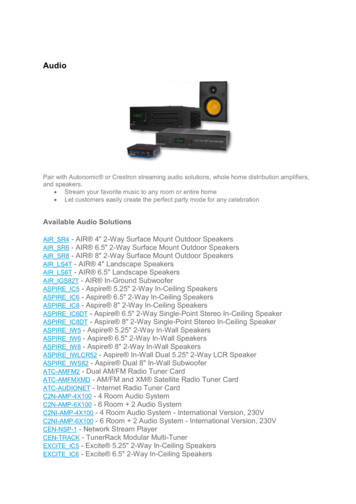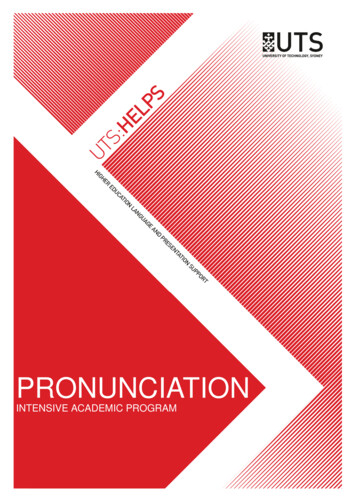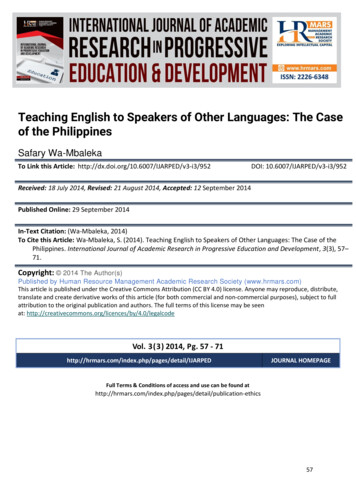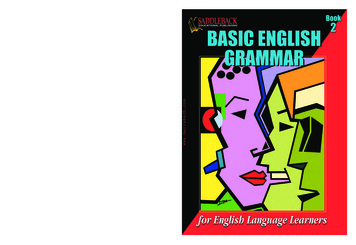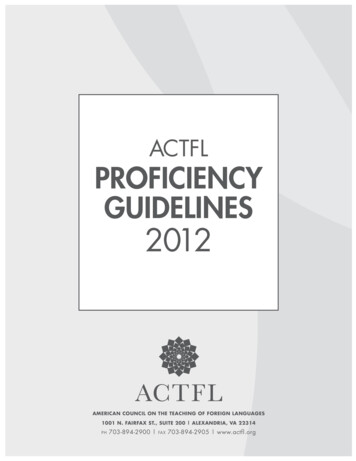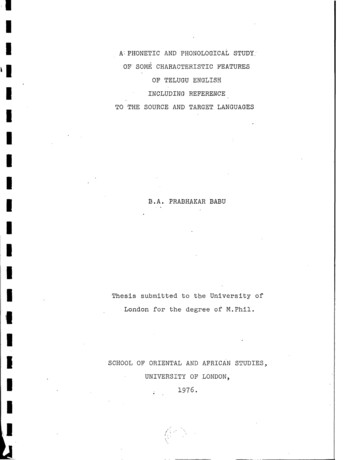
Transcription
The Praxis Study CompanionEnglish to Speakers ofOther Languages5362www.ets.org/praxis
Welcome to the Praxis Study CompanionWelcome to The Praxis Study CompanionPrepare to Show What You KnowYou have been working to acquire the knowledge and skills you need for your teaching career. Now you areready to demonstrate your abilities by taking a Praxis test.Using the Praxis Study Companion is a smart way to prepare for the test so you can do your best on test day. Thisguide can help keep you on track and make the most efficient use of your study time.The Study Companion contains practical information and helpful tools, including: An overview of the Praxis tests Specific information on the Praxis test you are taking A template study plan Study topics Practice questions and explanations of correct answers Test-taking tips and strategies Frequently asked questions Links to more detailed informationSo where should you start? Begin by reviewing this guide in its entirety and note those sections that you needto revisit. Then you can create your own personalized study plan and schedule based on your individual needsand how much time you have before test day.Keep in mind that study habits are individual. There are many different ways to successfully prepare for yourtest. Some people study better on their own, while others prefer a group dynamic. You may have more energyearly in the day, but another test taker may concentrate better in the evening. So use this guide to develop theapproach that works best for you.Your teaching career begins with preparation. Good luck!Know What to ExpectWhich tests should I take?Each state or agency that uses the Praxis tests sets its own requirements for which test or tests you must take forthe teaching area you wish to pursue.Before you register for a test, confirm your state or agency’s testing requirements at www.ets.org/praxis/states.How are the Praxis tests given?Praxis tests are given on computer. Other formats are available for test takers approved for accommodations (seepage 44).The Praxis Study Companion2
Welcome to the Praxis Study CompanionWhat should I expect when taking the test on computer?When taking the test on computer, you can expect to be asked to provide proper identification at the testcenter. Once admitted, you will be given the opportunity to learn how the computer interface works (how toanswer questions, how to skip questions, how to go back to questions you skipped, etc.) before the testing timebegins. Watch the What to Expect on Test Day video to see what the experience is like.Where and when are the Praxis tests offered?You can select the test center that is most convenient for you. The Praxis tests are administered through aninternational network of test centers, which includes Prometric Testing Centers, some universities, and otherlocations throughout the world.Testing schedules may differ, so see the Praxis web site for more detailed test registration information at www.ets.org/praxis/register.The Praxis Study Companion3
Table of ContentsTable of ContentsThe Praxis Study Companion guides you through the steps to success1. Learn About Your Test.5Learn about the specific test you will be taking2. F amiliarize Yourself with Test Questions.9Become comfortable with the types of questions you’ll find on the Praxis tests3. Practice with Sample Test Questions. 13Answer practice questions and find explanations for correct answers4. Determine Your Strategy for Success. 22Set clear goals and deadlines so your test preparation is focused and efficient5. Develop Your Study Plan. 25Develop a personalized study plan and schedule6. Review Study Topics. 29Review study topics with questions for discussion7. Review Smart Tips for Success. 42Follow test-taking tips developed by experts8. Check on Testing Accommodations. 44See if you qualify for accommodations to take the Praxis test9. Do Your Best on Test Day. 45Get ready for test day so you will be calm and confident10. Understand Your Scores. 47Understand how tests are scored and how to interpret your test scoresAppendix: Other Questions You May Have . 49The Praxis Study Companion4
Step 1: Learn About Your Test1. Learn About Your TestLearn about the specific test you will be takingEnglish to Speakers of Other Languages (5362)Test at a GlanceTest NameEnglish to Speakers of Other LanguagesTest Code5362Time120 minutesNumber of Questions120 selected-response questionsFormatSelected-response questions; This test may include questions with an audiocomponent.Test DeliveryComputer deliveredContent CategoriesVIIVIIIVIIIApproximateNumber ofQuestionsApproximatePercentage ofExaminationI.Foundations of Linguistics2218%II.Foundations of Language Learning2622%III. Planning and Implementing Instruction2823%IV. Assessment and Evaluation1815%V.1311%1311%CultureVI. Professionalism and AdvocacyAbout This TestThe English to Speakers of Other Languages (ESOL) test is designed to measure basic linguistic and pedagogicalknowledge for those interested in working in the context of teaching ESOL in elementary or secondary schools.Candidates usually come from a variety of backgrounds. Some are preservice teachers who are recent graduatesof an ESOL degree program, some may be experienced ESOL teachers moving from a different state, whileothers are current teachers who have changed from their content area of education to ESOL.The Praxis ESOL test is categorized into six content categories of expertise, as shown in the pie chart above.Candidates are expected to demonstrate the knowledge and skills required of a beginner-level K-12 ESOLteacher. The six content categories were identified, via rigorous content analyses, by nationally recognizedthought leaders in the field of TESOL and applied linguistics. Having basic knowledge in each category wasdeemed critical for the beginning-level ESOL teacher.ETS works in collaboration with teacher educators, higher-education content specialists, and accomplishedteachers to keep the test updated and representative of current and relevant standards.ETS has aligned the questions on this test with the Standards for the Recognition of Initial TESOL Programs in P-12ESL Teacher Education, developed by TESOL International Association and the Council for the Accreditation ofEducator Preparation (CAEP).Test takers have two hours to complete 120 multiple-choice questions, which have listening questionsThe Praxis Study Companion5
Step 1: Learn About Your Testembedded throughout the test. For the listeningquestions, test takers have an opportunity to listento a recorded prompt multiple times, taking intoaccount time considerations. Some of the questionsask candidates to choose more than one answer,which helps to capture the breadth of a candidate’sknowledge.This test may contain some questions that will notcount toward the test taker’s total score.Test SpecificationsTest specifications in this chapter describe theknowledge and skills measured by the test. Studytopics to help you prepare to answer test questionscan be found on page 36.I.Foundations of LinguisticsA.Understands phonetics, stress and intonationpatterns, and the effects of phonetic environmenton pronunciationB.Is familiar with IPA (the International PhoneticAlphabet)C.Understands the various types of morphemesand how they are used in word formationII.Foundations of Language LearningA.Understands the distinction between social andacademic language functionsB.Understands the similarities and differencesbetween first and second language acquisition,and how learners’ first language can affect theirsecond-language production and receptionC.Understands the processes of second-languageacquisition including research-based modelsD.Knows the different types of affective factors andtheir implications for the second-languagelearning processE.Understands the relationship between Englishphonemes and graphemes and the rules ofphonicsF.Understands the literacy development of ELsG.Understands how first-language literacyinfluences the development of English literacyH.Understands that, in addition to language,student performance may be affected by variousfactors (e.g., socioeconomic, physical, emotional)III.Planning and Implementing InstructionA.Knows the implication of dialect variation for theinstruction of English learnersB.Understands various methods and approaches inteaching ELs and knows how to select the mostappropriate methods for the contextD.Understands the usage of English syntaxE.Understands the parts of speech including theirstructural, semantic, and functional characteristicsF.Understands semantics and how combinations ofwords convey meaningC.G.Knows that languages differ from or are similar toeach other in their phonology, morphology,syntax, semantics, and pragmaticsKnows a variety of instructional delivery modelsspecific for ELsD.H.Understands the concepts of pragmaticsKnows how to identify appropriate andmeasureable objectives that align to languageand content standardsI.Understands the concepts of sociolinguisticsE.J.Knows the concept of World EnglishesKnows how to design appropriate classroomactivities that connect to learning objectives forELsK.Understands the conventions of written English(i.e., mechanics)F.Knows how to design appropriate assessmentsthat connect to learning objectives for ELsL.Understands the rhetorical patterns and range ofgenres used in written EnglishG.M.Understands communicative competenceN.Know about the inconsistencies and irregularitiesof the English languageIs familiar with ways to collaborate with othereducators in designing classroom activitiesappropriate to the proficiency levels of EnglishlearnersH.Knows how to effectively integrate the fourdomains of language (i.e., speaking, listening,reading, and writing) into instructionI.Knows how to promote ELs’ acquisition ofreceptive and productive skillsJ.Knows how and when to apply a variety ofThe Praxis Study Companion6
Step 1: Learn About Your Teststrategies for teaching language skillscontextually or targeting them discretelyAssessment and EvaluationA.Knows the role of assessment in the identification,placement, and exit from language-supportprogramsB.Understands a variety of formal and informalmethods to assess receptive and productivelanguage skillsC.Knows how to develop and administer formativeand summative classroom assessments todetermine ELs’ language skills, inform instruction,and document student growthUnderstands effective practices for teachingliteracy to English learnersD.Knows there are a variety of accommodations forstate-mandated content-area testing for ELsUnderstands how to select, modify, and/or createculturally responsive, age-appropriate, andlinguistically accessible teaching materials andresources to support EL’s learning styles andneedsE.Knows ways to adapt classroom assessments forELsF.Knows that some ELs may be eligible for specialeducation and/or gifted and talented servicesand is familiar with how to provide feedback andinput about assessment dataG.Is familiar with assessment-related issues such asvalidity, reliability, and language and cultural biasH.Knows the difference between norm-referencedand criterion-referenced assessments, and howthey are used with ELsK.Knows how to promote autonomous learningthrough cognitive and metacognitive strategieswith ELsL.Understands techniques that activate students’prior knowledge and that build new knowledgeto support acquisition of content and languageM.Knows how to organize instruction that providesstudents with meaningful opportunities to uselanguageN.O.P.IV.Is familiar with how technologies can be used tosupport language development, instruction andlearningQ.Understands how to create a secure, supportive,and culturally respectful learning environment forELsR.Knows how and when to use constructivefeedback to facilitate English-language learningI.S.Knows how to create a language-, text-, andprint-rich environment at a linguistic and anage- appropriate level that promotes academicgrowthKnows how to interpret assessment data and useit to assist in planning and differentiatinginstruction for ELsJ.Is familiar with strategies for communicatingassessment data to English learners and theirguardiansT.Understands how to differentiate instruction forELs based on individual student needs andlanguage proficiency levelsU.Knows how to recognize and be instructionallyresponsive to Students with Limited orInterrupted Formal Education (SLIFE), formerlyknown as Students with Interrupted FormalEducation (SIFE)V.Understands that instruction will need to beadapted for ELs receiving special education orgifted servicesW.Understands the importance of languagemodeling, comprehensible input and output, andscaffolding for English language learningThe Praxis Study Companion7
Step 1: Learn About Your TestV.CultureVI. Professionalism and AdvocacyA.Understands the ways cultural variables affectsecond-language acquisition and teachingKnows the possible differences betweendisabilities and typical language proficiencydevelopmentB.C.Understands the ways students’ identities andlearning styles will vary widely across and withinculturesKnows how to value and incorporate diversecultures of students into instructionC.D.Understands the implications of culturalstereotyping, cultural bias, and cultural bullying inthe school settingUnderstands the legal provisions and ethicalimplications of laws and federal court decisionsrelated to the education of ELsD.Understands the need to serve as a professionalresource and advocate for ELs and familiesE.Knows that cultural experiences influencestudent language development, disposition, andlearningE.Understands the need to communicate withschool personnel about the characteristics andemotional, social, and physical needs of ELsF.Understands that the teacher’s personal andcultural experiences influence teaching styleF.G.Understands the difference betweenacculturation and assimilationKnows how to identify appropriate strategies forplanning and collaborating with ELs, theirfamilies, and school and community membersG.Understands ways to collaborate with otherschool personnel regarding the academic needsof ELsH.Is familiar with ways that ELs and their familiesmay benefit from a variety of outside resources(e.g., services, networks, organizations)I.Knows a variety of strategies for consulting withguardians and communicating with them abouteach student’s progress and needsJ.Knows the importance of engaging inprofessional development by continuallyresearching relevant and reliable resources andorganizations in the field of teaching ESOLA.Understands the interrelationship betweenlanguage and cultureB.The Praxis Study Companion8
Step 2: Familiarize Yourself with Test Questions2. Familiarize Yourself with Test QuestionsBecome comfortable with the types of questions you’ll find on the Praxis testsThe Praxis assessments include a variety of question types: constructed response (for which you write aresponse of your own); selected response, for which you select one or more answers from a list of choices ormake another kind of selection (e.g., by clicking on a sentence in a text or by clicking on part of a graphic); andnumeric entry, for which you enter a numeric value in an answer field. You may be familiar with these questionformats from taking other standardized tests. If not, familiarize yourself with them so you don’t spend timeduring the test figuring out how to answer them.Understanding Computer-Delivered QuestionsQuestions on computer-delivered tests are interactive in the sense that you answer by selecting an optionor entering text on the screen. If you see a format you are not familiar with, read the directions carefully. Thedirections always give clear instructions on how you are expected to respond.For most questions, you respond by clicking an oval to select a single answer from a list of answer choices.However, interactive question types may also ask you to respond by: Clicking more than one oval to select answers from a list of choices. Typing in an entry box. When the answer is a number, you may be asked to enter a numerical answer.Some questions may have more than one place to enter a response. Clicking check boxes. You may be asked to click check boxes instead of an oval when more than onechoice within a set of answers can be selected. Clicking parts of a graphic. In some questions, you will select your answers by clicking on a location (orlocations) on a graphic such as a map or chart, as opposed to choosing your answer from a list. Clicking on sentences. In questions with reading passages, you may be asked to choose your answers byclicking on a sentence (or sentences) within the reading passage. Dragging and dropping answer choices into targets on the screen. You may be asked to select answersfrom a list of choices and drag your answers to the appropriate location in a table, paragraph of text orgraphic. Selecting answer choices from a drop-down menu. You may be asked to choose answers by selectingchoices from a drop-down menu (e.g., to complete a sentence). Clicking on specific icons to play an audio file. For listening questions, which are embedded within thetest, you are asked to click on an icon to listen to a student speak as many times as necessary, keeping inmind time considerations. Answer choices are presented on the same page, where the test taker canchoose the correct answer among four choices. At the time of the test administration, make sure yourheadphones are in good working order before starting the test.Remember that with every question you will get clear instructions.Perhaps the best way to understand computer-delivered questions is to view the Computer-delivered TestingDemonstration on the Praxis web site to learn how a computer-delivered test works and see examples ofsome types of questions you may encounter.The Praxis Study Companion9
Step 2: Familiarize Yourself with Test QuestionsUnderstanding Selected-Response QuestionsMany selected-response questions begin with the phrase “which of the following.” Take a look at this example:Which of the following is a flavor made from beans?(A) Strawberry(B) Cherry(C) Vanilla(D) MintHow would you answer this question?All of the answer choices are flavors. Your job is to decide which of the flavors is the one made from beans.Try following these steps to select the correct answer.1) L imit your answer to the choices given. You may know that chocolate and coffee are also flavors madefrom beans, but they are not listed. Rather than thinking of other possible answers, focus only on the choicesgiven (“which of the following”).2) E liminate incorrect answers. You may know that strawberry and cherry flavors are made from fruit andthat mint flavor is made from a plant. That leaves vanilla as the only possible answer.3) V erify your answer. You can substitute “vanilla” for the phrase “which of the following” and turn thequestion into this statement: “Vanilla is a flavor made from beans.” This will help you be sure that your answeris correct. If you’re still uncertain, try substituting the other choices to see if they make sense. You may wantto use this technique as you answer selected-response questions on the practice tests.Try a more challenging exampleThe vanilla bean question is pretty straightforward, but you’ll find that more challenging questions have asimilar structure. For example:Entries in outlines are generally arranged accordingto which of the following relationships of ideas?(A) Literal and inferential(B) Concrete and abstract(C) Linear and recursive(D) Main and subordinateYou’ll notice that this example also contains the phrase “which of the following.” This phrase helps youdetermine that your answer will be a “relationship of ideas” from the choices provided. You are supposed to findthe choice that describes how entries, or ideas, in outlines are related.Sometimes it helps to put the question in your own words. Here, you could paraphrase the question in this way:“How are outlines usually organized?” Since the ideas in outlines usually appear as main ideas and subordinateideas, the answer is (D).The Praxis Study Companion10
Step 2: Familiarize Yourself with Test QuestionsQUICK TIP: Don’t be intimidated by words you may not understand. It might be easy to be thrown by wordslike “recursive” or “inferential.” Read carefully to understand the question and look for an answer that fits. Anoutline is something you are probably familiar with and expect to teach to your students. So slow down, anduse what you know.Watch out for selected-response questions containing “NOT,” “LEAST,” and “EXCEPT”This type of question asks you to select the choice that does not fit. You must be very careful because it is easyto forget that you are selecting the negative. This question type is used in situations in which there are severalgood solutions or ways to approach something, but also a clearly wrong way.How to approach questions about graphs, tables, or reading passagesWhen answering questions about graphs, tables, or reading passages, provide only the information that thequestions ask for. In the case of a map or graph, you might want to read the questions first, and then look at themap or graph. In the case of a long reading passage, you might want to go ahead and read the passage first,noting places you think are important, and then answer the questions. Again, the important thing is to be sureyou answer the questions as they refer to the material presented. So read the questions carefully.How to approach unfamiliar formatsNew question formats are developed from time to time to find new ways of assessing knowledge. Tests mayinclude audio and video components, such as a movie clip or animation, instead of a map or reading passage.Other tests may allow you to zoom in on details in a graphic or picture.Tests may also include interactive questions. These questions take advantage of technology to assessknowledge and skills in ways that standard selected-response questions cannot. If you see a format you arenot familiar with, read the directions carefully. The directions always give clear instructions on how you areexpected to respond.QUICK TIP: Don’t make the questions more difficult than they are. Don’t read for hidden meanings or tricks.There are no trick questions on Praxis tests. They are intended to be serious, straightforward tests ofyour knowledge.Understanding Constructed-Response QuestionsConstructed-response questions require you to demonstrate your knowledge in a subject area by creatingyour own response to particular topics. Essays and short-answer questions are types of constructed-responsequestions.For example, an essay question might present you with a topic and ask you to discuss the extent to which youagree or disagree with the opinion stated. You must support your position with specific reasons and examplesfrom your own experience, observations, or reading.Take a look at a few sample essay topics: “ Celebrities have a tremendous influence on the young, and for that reason, they have a responsibility toact as role models.” “ We are constantly bombarded by advertisements—on television and radio, in newspapers andmagazines, on highway signs, and the sides of buses. They have become too pervasive. It’s time to putlimits on advertising.” “ Advances in computer technology have made the classroom unnecessary, since students and teachersare able to communicate with one another from computer terminals at home or at work.”The Praxis Study Companion11
Step 2: Familiarize Yourself with Test QuestionsKeep these things in mind when you respond to a constructed-response question1) A nswer the question accurately. Analyze what each part of the question is asking you to do. If thequestion asks you to describe or discuss, you should provide more than just a list.2) A nswer the question completely. If a question asks you to do three distinct things in your response,you should cover all three things for the best score. Otherwise, no matter how well you write, you willnot be awarded full credit.3) A nswer the question that is asked. Do not change the question or challenge the basis of thequestion. You will receive no credit or a low score if you answer another question or if you state, forexample, that there is no possible answer.4) G ive a thorough and detailed response. You must demonstrate that you have a thoroughunderstanding of the subject matter. However, your response should be straightforward and not filledwith unnecessary information.5) R eread your response. Check that you have written what you thought you wrote. Be sure not toleave sentences unfinished or omit clarifying information.QUICK TIP: You may find that it helps to take notes on scratch paper so that you don’t miss any details. Thenyou’ll be sure to have all the information you need to answer the question.The Praxis Study Companion12
Step 3: Practice with Sample Test Questions3. Practice with Sample Test QuestionsAnswer practice questions and find explanations for correct answersComputer DeliveryThis test is available via computer delivery. The following sample question provides a preview of an actualscreen used in a computer-delivered test. For the purposes of this Study Companion, the sample questions areshown as they would appear in a paper-delivered test.The Praxis Study Companion13
Step 3: Practice with Sample Test QuestionsSample Test QuestionsThe sample questions that follow illustrate the kinds ofquestions on the test. They are not, however, representativeof the entire scope of the test in either content or difficulty.The answers and their explanations are provided later inthis chapter.Terminology: In this test, the following terminologymay appear as described. English to Speakers of Other Languages may bereferred to as ESOL. English as a Second Language may be referred toas ESL. English as a Foreign Language may be referred toas EFL An English-language learner may be referred to asan ELDirections: Each of the questions or statements belowis followed by four suggested answers or completions.Select the one that is best in each case.1. An EL approaches the ESOL teacher andsays, “Give me a piece of paper.” The EL’sutterance is best characterized as an error in(A) article usage(B) word order(C) register(D) conjugation2. Which of the following terms refers to how thelevel of a language learner’s negative feelingsand motivation correlates to his or her abilityto acquire new language skills?(A) Deductive reasoning Teachers of English to Speakers of Other Languagesmay be referred to as TESOL.(B) Extrinsic reinforce The National Association for Bilingual Education may bereferred to as NABE.(D) Self-regulated learning The Center for Applied Linguistics may be referred toas CAL. Basic interpersonal communication skills may bereferred to as BICS. Cognitive academic language proficiency may bereferred to as CALP. The Cognitive Academic Language Learning Approachmay be referred to as CALLA. The Sheltered Instruction Observation Protocol Modelmay be referred to as the SIOP Model. A first language may be referred to as the L1. A second language may be referred to as the L2. Total Physical Response may be referred to as TPR. A parent or legal guardian may be referred to asa parent. Second Language Acquisition may be referred to asSLA.The Praxis Study Companion(C) Affective filter3. Mr. Lewis, a new ESL teacher, is evaluatingseveral assessments that were used by theprevious ESL teacher. Because of the diversecultural backgrounds of his students, Mr.Lewis wants to ensure that the assessmentshe chooses to incorporate into the curriculumdo not exhibit any cultural bias. Which of thefollowing is the most appropriate question forMr. Lewis to use as a guideline whenscreening the assessments for cultural bias?(A) Was the ESL teacher who designed theassessments fluent in more than onelanguage?(B) Will the students need a high level ofsociopragmatic competence to completethe assessments?(C) Are the scores that students received onthe assessments in the past reliable?(D) Do the assessments separate contentarea learning from language learning?14
Step 3: Practice with Sample Test Questions4. A high school ESOL teacher gives studentsthe following work sheet.7. Subtractive bilingualism is most likely to occurin second-language learners who(A) have difficulty understanding contentarea vocabulary(B) have little opportunity to continue usingtheir first language(C) work to maintain the customs of theirhome culturesThe primary purpose of the work sheet is toprovide instruction on(A) morphology(B) stress(C) intonation(D) syllabication5. Which of the following court cases resulted ina ruling that district-implemented programsfor ELs must be evaluated for effectiveness?(A) Lau v. Nichols(D) had limited formal schooling in theirhome countries8. Which of the following makes the gre
The English to Speakers of Other Languages (ESOL) test is designed to measure basic linguistic and pedagogical . strategies for teaching language skills contextually or targeting them discretely K. Knows how to promote autonomous learning . feedback to facilitate English-language learning S. Knows how to create a language-, text-, and
